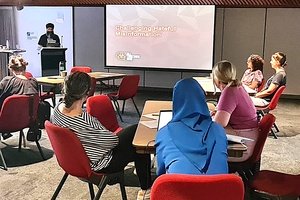In a submission to the Department of Health and Aged Care, the Australian Medical Association (AMA) said research suggests young people see 168 unhealthy food and drink promotions through social media each week.
This equates to 17 advertisements of junk food products for each hour a child is online, it said.
According to the National Obesity Strategy, more than $500 million is spent annually by food companies on advertising food and non-alcoholic drinks in Australia, with the majority for products high in sugar, salt and fat.
AMA president Professor Steve Robson believes an online marketing ban would help establish healthy food consumption habits from a young age.
“Limiting junk food advertisements and marketing is about nurturing health in our children, providing them with the opportunity to make healthy choices well into adulthood,” he said.
“Eating habits start young, when kids are highly susceptible to marketing ploys."
Australian children’s dietary habits are well below optimal, with high and frequent intakes of discretionary foods and beverages and inadequate intakes of some core food groups.
The most recent national survey of Australian children’s dietary behaviours was as far back as 2011/12, however even then it was revealed that fewer than one in 10 children (4-18 years) reported usual diets that met recommendations for vegetable intake.
At the same time, approximately 40 per cent of children’s energy intake was derived from discretionary foods and beverages and almost half of all children had consumed sugar-sweetened beverages on the day before the survey.

Robson believes an online marketing ban would help establish healthy food consumption habits from a young age.
Further, National Health Survey data indicate almost one in four children aged 2-17 years were overweight or obese in 2017-18, with higher prevalence among those living in more disadvantaged neighbourhoods and among Aboriginal and Torres Strait Islander children.
The AMA submission highlights the preventative health benefits of a so-called digital black-out on junk food adverts, and calls for restrictions on all junk food marketing across media platforms and outlets between 5.30pm and 11pm.
“Junk food marketing at the sports field, in the shops, on TV or online gives the wrong message by making unhealthy food completely normal,” Robson said.
The peak body is also calling on the Government to implement tight restrictions on unhealthy food sponsorships of sports, arts and cultural issues.
“Children should be able to play sport, watch their favourite sport stars play and go to art and cultural events without being bombarded with marketing for unhealthy food,” Robson said.
And it’s abundantly clear that the unsavoury message is getting through – overweight and obesity, and dietary risk factors are the second and third leading risk factors for death and disease in Australia, respectively.
In childhood and adolescence, excess body weight is associated with increased risk of: metabolic disorders, including type 2 diabetes mellitus and fatty liver disease; respiratory illnesses, including asthma and obstructive sleep apnoea; coronary heart disease; orthopaedic complications; and mental health conditions, including depression.
Research has also shown that excess body weight in childhood tracks into adulthood, with obese children and adolescents around five times more likely to be obese in adulthood.
This has subsequent complications across the life course, contributing to accumulating individual poor health and resource implications for paediatric and adult health services.
It’s for these reasons and many more that the AMA wants more regulation in the unhealthy food advertisement industry, and has urged the Government to challenge the status quo of the industry being able to regulate itself.
“Allowing the processed food and advertising industries to set their own rules does not effectively protect children from exposure to unhealthy food marketing,” Robson said.
He said unhealthy food and drink marketing undermines healthy food education and normalises the consumption of junk food.
Meanwhile, with more research revealing the importance of a good diet, especially during school hours, for the health and wellbeing of children, the Federation of Canteens in Schools (FOCIS) has convened for its first National School Network Meeting of 2024.

FOCIS's mission is to deliver program updates, and start discussions around current trends, research, and what canteen associations, networks, and its members can do together to meet the broader needs of young children and school canteen operators.
In a collegial atmosphere of knowledge sharing and cross-collaboration, participants, including many stakeholders working in the sector, heard from a range of initiatives and programs that partner with school canteens across the country to support the provision of healthy foods and encourage the adoption of healthy eating habits.
FOCIS Chairperson Leanne Elliston said that fantastic things were happening in each of the jurisdictions across the country, from members working with canteens in low socio-economic areas to incorporate fruit breaks, to school children in regional areas opening and operating their very own school canteens offering healthy options to their peers.
Each state and territory has differing policies to help parents and children identify healthier options, and while food audits and traffic light systems help, sustainable long-term change can only succeed through a whole-school approach that incorporates the broader community and involves students, parents, and teachers in the process.
Their efforts can only be assisted by a successful limit on junk food ads and marketing.
“It is really important FOCIS provides a platform for unified discussion and a collaborative approach to the escalating challenges posed by childhood obesity, nutritional disparities, economic factors, and the overall wellbeing of our young generation,” Elliston said.
Ellison said the mission of FOCIS and canteen associations, networks, and its members is to share knowledge, deliver program updates, and start discussions around current trends, research, and what we can do together to meet the broader needs of young children and school canteen operators.
“The movement to gravitate towards wholesome and nutritious meal options isn’t a quick one, especially when we are up against the marketing might of multi-national food companies with million-dollar campaigns,” she bemoaned.
“It’s why the coming together and leveraging of ideas and opportunities through the National School Food Network is so important.”
The meeting also featured a discussion on the need for a centralised database of how many school canteens are operating in the country, and the current limitations on transparency when it comes to school canteen menus.
Like the AMA, FOCIS has been lobbying the Federal Government and recently provided a submission to the Albanese Government consultation on limiting unhealthy food marketing to children.
Having closed its public submissions on March 15, the consultation is exploring policy options to limit unhealthy food marketing to children, including associated costs and benefits, feasibility, acceptability, impact on priority populations and monitoring and evaluation implications.
It is clear that most Australians want action to protect children, with a Cancer Council Victoria 2022 Shape of Australia survey of more than 2300 Australians aged 18 to 65 years finding that just over 7 in 10 (72 per cent) were in favour of Government taking action to stop unhealthy food and sugary drink marketing on TV during children’s viewing times, just over 7 in 10 (71 per cent) in favour of Government action to shield children from exposure to unhealthy online marketing, and 7 in 10 (71 per cent) believing it should be prohibited on social media for all children under 18.














